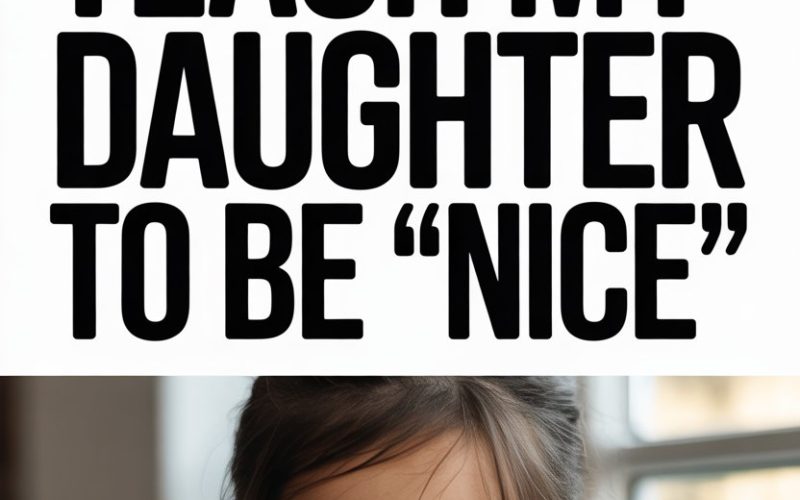It sounds a bit scandalous, doesn’t it? Surely, raising a nice child is Parenting 101.
But if you’re picturing me as the mum on the playground encouraging my daughter to snatch toys and insult grandmas, rest assured: that’s not the case.
The “nice” I’m talking about is the watered-down variety—polished politeness, compulsory smiles, and apologising for taking up space.
Here’s why I tossed that old script out the window, and what’s happened since.
What Does “Nice” Even Mean?
Ask ten adults to define “nice” and you’ll get twelve different answers. For some, it’s being agreeable. For others, it’s never causing a fuss.
My own recollections of girlhood are peppered with grown-ups urging me to “be nice” whenever I dared to challenge, disagree, or—heaven forbid—assert myself.
The subtext: Nice means quiet, compliant, and easy to manage.
Once you start noticing it, you’ll spot this pattern everywhere, especially with girls.
Research from the Girl Scouts found that girls as young as six start feeling pressure to be likeable at all costs. Boys? Not so much.
That’s not just outdated—it can be harmful.
Why “Nice” Can Set Kids Up for Trouble
Picture your child at school. A classmate corners her, demanding her lunch. If she’s been taught nice at all costs, chances are she’ll hand it over to avoid rocking the boat.
Nice, in this context, can mean ignoring your own needs to keep everyone else comfortable. It encourages kids to mask their true feelings, sidestep boundaries, and apologise for things that aren’t their fault.
No one wants “Mean Girls” in miniature, but raising a doormat is no prize either.
Experts in child psychology echo this concern. Teaching kids (especially girls) to prioritise being nice above all else can leave them vulnerable to manipulation and even unsafe situations.
Kindness Over Niceness—The Crucial Difference
The antidote isn’t rudeness. It’s kindness. They aren’t twins.
Kindness means empathising with others, taking action to help, and showing respect—including for yourself. Niceness is surface-level, often motivated by fear of disapproval.
You can be kind and still say “no.” You can be kind and have boundaries. You can be kind and let your actual feelings show—without the world ending.
At home, my daughter has learnt that she doesn’t have to hug relatives if she doesn’t want to (cue gasps from the peanut gallery). She practices saying, “No, thank you,” and sees that her preferences are respected.
The sky hasn’t fallen. Instead, she’s learnt what genuine warmth looks like—not because she’s told to perform it, but because she feels it.
Boundaries: The Gift That Keeps on Giving
Boundaries are the unsung heroes of happy, healthy relationships. Yet, when we push kids to be nice, we often teach them to ignore those internal alarm bells.
No one wants their child to be the one tattling constantly, but it’s far more dangerous for them to clam up out of politeness. In our house, “making a fuss” is just another way of saying, “speaking up when something isn’t right.”
If my daughter’s playdate makes her uncomfortable, she knows she can say so—and that I’ll back her up.
This doesn’t mean she never has to compromise or share. Life isn’t a solo act. But her needs and feelings are just as important as anyone else’s.
How We Model Assertiveness (Without Raising a Tiny Tyrant)
This all sounds heart-warming until your kid morphs into a bossy dictator. Don’t worry. Kids can absolutely learn assertiveness without steamrolling their mates.
In fact, child development research shows that assertiveness is linked to higher self-esteem and better peer relationships—not the other way around.
Here’s a typical script at our house:
- “It’s OK to say no politely.”
- “You don’t have to answer personal questions you don’t want to.”
- “You’re allowed to disagree with someone, even if it makes them upset.”
It’s one thing to say these words, but children are master mimics. If they see their parents apologising for existing, they’ll do the same.
I practise backing myself (sometimes through gritted teeth). When I mess up, I let her see that too—modelling that adults make mistakes and boundaries are a work-in-progress.
When Being “Not Nice” Is the Right Call
There are times when politeness is exactly the wrong response. Any parent who’s watched a child freeze under peer pressure knows the gut-churning fear: Will my child say “no”? Or will she cave, not wanting to seem rude?
That’s why we rehearse scenarios, sometimes in the car, sometimes at bedtime:
- “If someone tells you to keep a secret that makes you feel yucky, you can tell me.”
- “If you don’t want to play a game, you can say, ‘No thanks.’”
Roleplay sounds naff, but it works. Studies back up that practising assertive phrases actually helps children use them in real life.
And if that makes her less “nice” and more safe? I’ll take it.
The Gendered Expectations Trap
Maybe you’ve noticed that girls are expected to be sugar and spice, while boys can leap off the sofa and roar like wild animals.
Parents of boys are applauded for raising “strong-willed” sons, while a girl’s strength is often labelled as “bossy” or “difficult.”
We need to call this what it is: a double standard. If my daughter wants to negotiate her bedtime or challenge a playground injustice, she’s not being “too much”—she’s practising essential life skills.
Here’s a zinger for family gatherings: “She’s not being rude, she’s expressing herself.” Try serving that with dessert.
Practical Ways to Raise More Than Just “Nice” Kids
You want your kids to be decent humans—ones who look out for others, but also themselves. This doesn’t take a PhD in child development nor a Pinterest board full of elaborate crafts.
Here’s what’s actually worked for our family:
- Let kids disagree with you (respectfully). They learn how to have hard conversations.
- Encourage them to trust their gut. If something feels wrong, it probably is.
- Praise acts of kindness rooted in empathy, not just compliance. “You helped your friend because you knew she was sad,” not just “You shared because you had to.”
- Use books and stories. So many children’s stories feature passive princesses; mix in stories with bold, opinionated heroes. Try “The Paper Bag Princess” if you need a starting point.
- Model healthy disagreement. Let your kids see you say, “I don’t agree, but I respect your view.”
- Teach them phrases that signal boundaries: “I don’t like that,” “Please stop,” or, my personal favourite for teens, “That’s not OK with me.”
None of this means raising a child who can’t cooperate, apologise, or admit fault. It just means giving them permission to exist as full humans, not tiny PR reps for the family.
Dealing with Pushback—from Well-Meaning Relatives and Strangers
Nothing sets off a debate quite like a child refusing to perform “niceness” on demand. Brace yourself for clucking tongues at holiday gatherings. You might hear:
- “She’s so shy!”
- “Why doesn’t she say hello?”
- “Aren’t you worried she’ll be rude?”
Truth is, adults are often more uncomfortable with boundary-setting kids than actual children are. The best response? Smile and say, “We’re teaching her to listen to her feelings,” or simply, “She’ll say hello when she’s ready.”
Some days, you’ll want to crawl under the buffet table. But these awkward moments pass, and your child gets the message that you’ve got her back.
What I Want for My Daughter
If you’re still unsure, ask yourself: Do you want your child to be liked, or do you want her to like herself? Would you rather she follows every rule and keeps the peace, or knows her own mind, even when it’s hard?
I want my daughter to be kind. I want her to be strong. Above all, I want her to know that her worth isn’t measured by her willingness to put others’ comfort before her own well-being.
She might not always be “nice.” But she’ll be real. She’ll know when to say yes and when to say no. And she’ll know that her parents stand firmly behind her—not just when she’s polite, but when she’s authentic.
Raising Kids Who Are More Than “Nice”
There’s nothing wrong with manners. Please and thank yous are currency in our house. But teaching kids to be “nice” at all costs is like handing them an umbrella with holes in it and calling it protection.
Tonight at bedtime, try asking your child, “What made you feel proud or strong today?” The answers might surprise you.
If we raise a generation of kids who know themselves, honour their boundaries, and lead with empathy—not performance—we’ll all be better off. Even if it ruffles a few feathers along the way.





